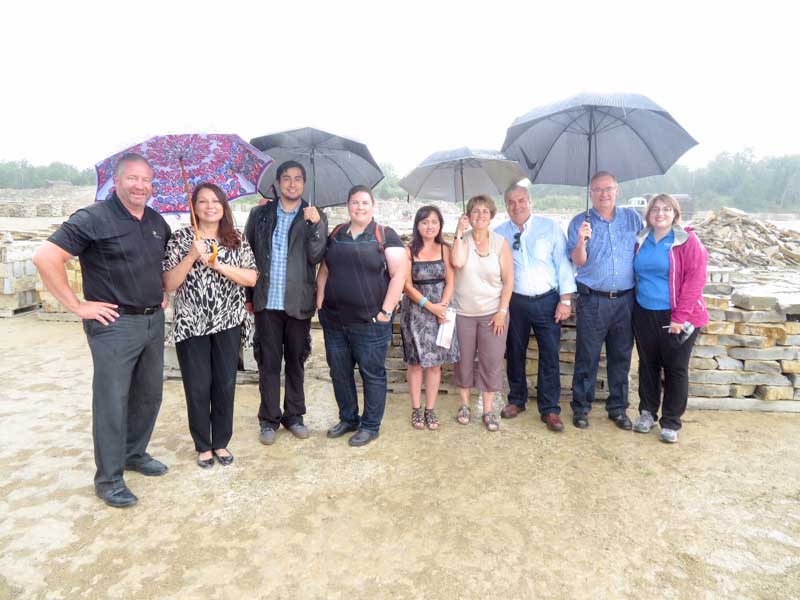Quarry operator clear that potential is in place for major economic driver
ASSIGINACK—Tracy Thomas knows her stone and she knows that with the assets in the ground at her Jay Bryant quarry she is sitting on a potential economic boom for Manitoulin Island that is unmatched by any other to be found in Assiginack. But while they may say that good help is hard to find, that is especially help trained in the niche skills required by a quarry, Ms. Thomas has a plan to deal with that, provided she can get a little help from her governments.
Ms. Thomas recently played host to one of the largest gatherings of public and private funders assembled to tour a project on Manitoulin, courtesy of the good officers of LAMBAC, the Island’s Community Futures Development Corporation.
“We are looking at ways to help the business,” confirmed LAMBAC manager Michael Addison. “We are trying to bring partners together. In three years this is the first time we have been able to assemble that large a group at the same time.”
Bringing that large of a group together is vital to finding the pathway to success as the scale of the project would likely far outstrip the available resources of any of the individual federal and provincial agencies. But by working together in concert and finding synergies where they may be able to intertwine, along with some innovative partnerships with local organizations that may go a long way toward dealing with transportation issues.
One of the major stumbling blocks for the Northern Natural Stone expansion is the state of the road leading into the operation. Jay Bryant Sideroad lies about 25 kilometres south of Little Current off of Highway 6. It, like many Island sideroads, is not an “official” municipal road. It is an unopened road allowance with a road use agreement between the Township of Assiginack and a previous owner of the property/business that stipulates the business owner assumes responsibility for the maintenance and upkeep of the road.
An industrious beaver and this summer’s very wet weather have each taken their toll. While the road is still navigable (The Expositor dropped by for a tour earlier this month), customers, especially those with large transports, have expressed reluctance to travel the road. Meanwhile, Ms. Thomas and the business are recovering from the challenges of a private domestic matter and they are both beginning to find their feet again—leaving tight resources to tackle the road and keep the doors open and people employed.
Ms. Thomas is a very determined entrepreneur, however, and she has been lobbying her local government to help her to bring badly needed employment to the municipality.
“I was disappointed that nobody from the town came to the meeting,” said Ms. Thomas, who said that she had extended the invitation. But Mayor Paul Moffatt said that he was not aware of the invitation. “I would like to have been on that tour,” he said. “It would be very interesting, I think.”
Both Algoma-Manitoulin MPP Mike Mantha and Algoma-Manitoulin-Kapuskasing MP Carol Hughes were also on the site tour and were very impressed with the potential.
“There is huge potential there,” said Mr. Mantha when contacted after the tour. “There is an opportunity to develop a trade that was once required that could become big once again—to turn a rock into a precious stone as the saying goes. I know College Boreal has been in discussions to look at working together with them. With the right investors and investment, and with MNDM and FedNor working together on it, there is great potential for targeted training, growth and, very importantly for that area, employment growth and jobs.”
Ms. Thomas is working on a soft skills course with the college that will assist with job readiness training in the local work force, and there are discussions around creating a course that would teach the very niche skills required of heavy equipment operators in a quarry environment.
“It’s challenging,” said Ms. Thomas. “I have people coming to me with a piece of paper that says they are qualified heavy equipment operators, but when I put them on a machine it becomes very clear that the skills they have don’t match the requirements of the job. There is a very good reason quarry operators, such as myself, require experience. If you get on my $250,000 loader and break it in the first half hour of working, production is down. We can’t afford that.”
As for the soft skills training and other issues, Ms. Thomas noted that there is a big difference in the new workers coming to her today. “I don’t know where the disconnect is,” she said, but she has a theory. “Kids used to work with their dads. They learned how to change oil in a machine, how to use a chainsaw or other equipment,” she said. “Somehow that got lost.”
Young workers are also missing key concepts such as ensuring they can have regular attendance at work and coming to work properly prepared. “This is hard, thirsty work,” she said. “I have people coming into work without water, without food, without the proper work clothes, you just can’t do this job like that.”
The two top reasons cited for absenteeism on her job site are “my child is sick and I can’t find a babysitter” and “I can’t find a ride.” These are challenges that will have to be addressed in order to be able to have a steady and dependable workforce.
“Hopefully, working together with partners we can find ways to fix these things,” she said.
Ms. Thomas currently has 1,027 skids of dressed stone in her yard. “At this point I really should have over 2,000,” she said. The inventory is essential if she is to tackle the large contracts that will be the lifeblood of her operation.
“In 10 years I could be employing 80 workers, in 12 years, 150 workers,” she said, “the market is there.”
Ms. Thomas has spent years building a market for the unique stone products available from Manitoulin’s rock. She has variegated stone that looks stunning in a wall or building face, super hard glaciated stone with an incredibly smooth finish that would be highly sought after, if she could get it out of the ground.
In the meantime, there is that road.
“They used to help out,” she said of the municipality.
But for the Assiginack council to assist they need to see a business case and, very importantly, receive a specific request directed to council.
The potential economic benefits make working together a highly desirable route to success that will benefit all sides. “I know stone,” asserts Ms. Thomas, but admits that negotiating the shoals of public and private funding “is something she will need help with.”
LAMBAC manager Mike Addison noted that his organization is willing to work with Ms. Thomas to put together the business plans she will need as a guide to the future.




